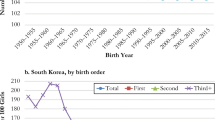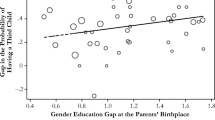Abstract
We examine the sex preference in Japan, using Japanese microdata, and find that parents in the 1920–1939 cohort have a lexicographic son preference. Further, the lexicographic son preference disappears in subsequent cohorts and a mixed preference is observed in parents with two children. These results are supported when the parents’ socioeconomic background is considered. Cohort effects such as weakening son preference and emerging mixed preference are observed. Moreover, when husbands are the eldest sons, a lexicographic son preference is observed only in the 1920–1939 cohort, although it persists in the subsequent cohorts when husbands are farmers/self-employed workers.


Similar content being viewed by others
Notes
This survey contains information on how many children the respondents have even if they have more than five children.
If we change this from 5 years to 10 years, the result of the following analysis in this section is similar.
We cannot have the ratio of no sons because there are no respondents born in 1965–1969 who have no sons.
The variables on the family background are suppressed. The authors can provide the complete tables upon request.
We calculate the semielasticity of the hazard with respect to explanatory variables x using \([\textit{e}^x -1] \times 100 \) if the coefficient is larger than 0.3.
Readers may think that there is multicollinearity between village, father_wife’s_name, father_agr_self, and father_eldest_son. However, the correlation coefficient between father_agr_self and village is the highest but is only 0.22.
References
Ahn N (1995) Measuring the value of children by sex and age using a dynamic programming model. Rev Econ Stud 62(3):361–379
Angrist JD, Evans WN (1998) Children and their parents’ labor supply: evidence from exogenous variation in family size. Am Econ Rev 88(3):450–477
Arnold F, Liu Z (1986) Sex preference, fertility, and family planning in China. Popul Dev Rev 12(2):221–246
Arroyo CR, Zhang J (1997) Dynamic microeconomic models of fertility choice: a survey. J Popul Econ 10(1):23–65
Ben-Porath Y, Welch F (1976) Do sex preferences really matter? Q J Econ 90(2):285–307
Clark S (2000) Son preference and sex composition of children: evidence from India. Demography 37(1):95-108
Cox DR (1972) Regression models and life tables. J R Stat Soc, Ser B 34:187–220
Graham MJ, Larsen U, Xu X (1998) Son preference in Anhui Province, China. Int Fam Plann Perspect 24(2):72–77
Grambsch PM, Therneau TM (1994) Proportional hazards tests and diagnostics based on weighted residuals. Biometrika 81(3):515–526
Gray E, Duckworth D, Nakajima Y (1980) The human sex ratio and factors influencing family size in Japan. J Heredity 71(6):411–415
Gu B, Roy K (1995) Sex ratio at birth in China, with reference to other areas in East Asia: what we know? Asia-Pac Popul J 10(3):17–42
Hank K, Kohler HP (2000) Gender preferences for children in Europe: empirical results from 17 FFS countries. Demographic Research 2(1)
Haughton D (1997) Packages for estimating finite mixtures: a review. Am Stat 51(2):194–205
Haughton D, Haughton J (1996) Using a mixture model to detect son preference in Vietnam. J Biosoc Sci 28(3):355–365
Haughton J, Haughton D (1998) Are simple tests of son preference useful? An evaluation using data from Vietnam. J Popul Econ 11(4):495–516
Horioka CY, Fujisaki H, Watanabe W, Kouno T (2000) Are Americans more altruistic than the Japanese? A U.S.–Japan comparison of saving and bequest motives. Int Econ J 14(1):1–31
Hull TH (1990) Recent trends in sex ratios at birth in China. Popul Dev Rev 16(1):63–83
Japan: Ministry of Health, Labour and Welfare (2008) Vital statistics. Ministry of Health, Labour and Welfare, Tokyo
Konrad KA, Kunemund H, Lommerud KE, Robledo JR (2002) Geography of the family. Am Econ Rev 92(4):981–998
Larsen U, Chung W, Gupta MD (1998) Fertility and son preference in Korea. Popul Stud 52(3):317-325
Osman MI (1985) A note on the human sex ratio and factors influencing family size in Japan. J Heredity 76(2):141
Park CB, Cho N (1995) Consequences of son preference in a low-fertility society: imbalance of the sex ratio at birth in Korea. Popul Dev Rev 21(1):59–84
Sakai H (1989) Kodomo no Seibetsu ga Shusshou ni Ataeru Eikyo ni Tsuite (Child-sex effects on further births). Jinkou Mondai Kenkyuu (Journal of Population Problems) 189:18–30 (in Japanese)
Sakai H (1989) Gendai Nihonjin no Seibetsu Senkou ni tsuite: 2 shi no seibetsu patan to 2 shi shusshou no kankei kara (Sex preference for children among couples in Japan: relationship between the sex sequence of parity two and third birth). Shakai Shinrigaku Kenkyu (Research in Social Psychology) 4(2):117–125 (in Japanese)
Sakai H (1992) Kinnen ni okeru Kodomo no Seibetsu Senkou no Doukou to sono Shakai–Keizaiteki Sai (Recent trend in sex preferences for children among Japanese couples and their socio-economic differences). Shakai Shinrigaku Kenkyu (Research in Social Psychology) 7(2):75–84 (in Japanese)
Tsay WJ, Chu CYC (2005) The pattern of birth spacing during Taiwan’s demographic transition. J Popul Econ 18(2):323–336
Tuljapurkar S, Li N, Feldman MW (1995) High sex ratios in China’s future. Science 267:874–876
Zhou Y, Zheng Z (2005) Sex ratio of reported births between 1910 and 1969 in China. Presented at the CEPED-CICRED-INED Seminar on Female Deficit in Asia: Trends and Perspectives, Singapore, December 5–7, 2005. 16 p
Acknowledgements
We are greatly indebted to anonymous referees and Charles Yuji Horioka for their kind advice, comments, and discussion throughout the process of writing this paper. We would also like to thank Tetsushi Homma, Daiji Kawaguchi, Colin McKenzie, Hideki Mizukami, James Raymo, Kei Sakata, Shizuka Sekita, Sawako Shirahase, Keiko Tamada, and the seminar participants at the University of Toyama, the Japanese Economic Association meeting of September 2007, and Prof. Horioka’s graduate seminar for their helpful comments and discussions. In addition, we thank the National Family Research of Japan and the Information Center for Social Science Research on Japan, Institute of Social Science, University of Tokyo (SSJ Data Archive), for permitting us to use data from the study “Trails of Families in Post-War Japan” (in Japanese, Sengo Nihon no Kazoku no Ayumi) (SSJDA0400). We are also indebted to the Ministry of Education, Culture, Sports, Science and Technology of the Japanese government for the Grant-in-Aid for Scientific Research (numbers 18330068 and 19330062) for supporting this research.
Author information
Authors and Affiliations
Corresponding author
Additional information
Responsible editor: Junsen Zhang
Rights and permissions
About this article
Cite this article
Kureishi, W., Wakabayashi, M. Son preference in Japan. J Popul Econ 24, 873–893 (2011). https://doi.org/10.1007/s00148-009-0282-3
Received:
Accepted:
Published:
Issue Date:
DOI: https://doi.org/10.1007/s00148-009-0282-3




